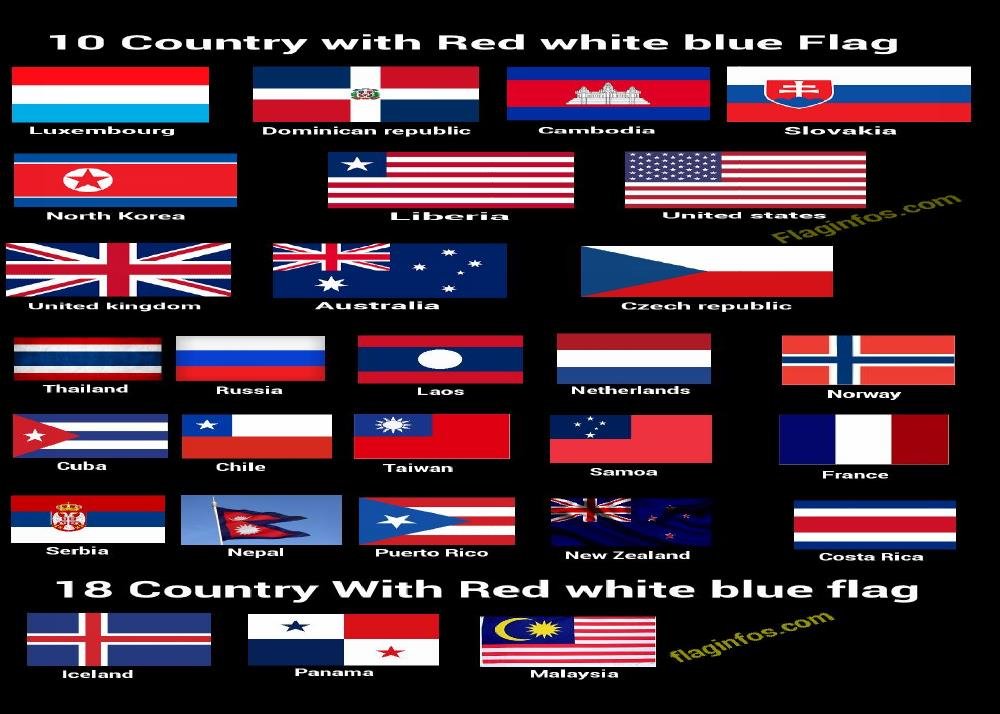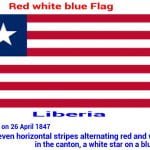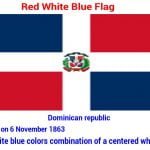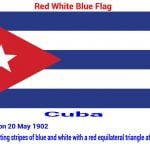Table of Contents
There are currently 29 countries with Red, White, Blue national flag. The color blue, white, and red may come in different variations and design, such as the flag of the United States, the United Kingdom(Union Jack), and the Tricolor flag of France, which are three of the most influential country flag in history both in Europe and the rest of the world.

countries with red white blue national flag
What does the Red White and Blue Flag Mean and Symbolizes
In many countries, the color red on the national Flag symbolizes and represents hardiness and valor, the white color represents peace and unity while the color blue represents justice and loyalty. some countries have similar flags to others, representing either one country and its colonies or a special relationship between the two nations such as the UK and Australia.

18 red-white-blue-flag-countries
The flag of the Netherlands and Luxembourg are very identical to each other but they are not the same. The shape is different the Netherlands flag is a 2:3 ratio and the Luxembourg one is a 3:5 ratio. Also, the blue and red on the Netherlands flag are much deep and darker in color. It was inspired by the French flag while the Luxembourg flag was inspired by their own traditional coat of arms.
Check out more country Flag
African Countries with Star Symbol On Their National flag (Meaning and Design)
Blue Yellow Flag (Countries, States, Symbols, Meaning and Fact)
Green White Orange Flag (Countries, Symbols, Meaning and Fact)
List of Country with Red White Blue Flag
| Country | Adopted Year | Flag Image | Meaning |
|---|---|---|---|
| United states | July 4, 1960 |
| The color red symbolizes hardiness, white symbolizes purity and innocence, and blue represents vigilance. Read More |
| United kingdom | 1 January 1801 |
| White represents peace, Red symbolizes bravery, Blue represents vigilance. Read More |
| Australia | 14 April 1954 |
| The Southern Cross is shown on the flag in white. The red stripe on the flag represents the Australian Army, the dark blue stripe represents the Royal Australian Navy and the light blue stripe represents the Royal Australian Air Force. Read More |
| Czech republic | 30 March 1920 |
| The white color stands for the people of the Czech Republic. Red color means courage, and blue symbolizes vigilance and truth. Read More |
| Liberia | 26 April 1847 |
| The red and white on the Liberian flag symbolize courage and moral excellence. The white star represents the first independent republic in Africa. Read More |
| North Korea | 8 September 1948 |
| The colors of the North Korean flag – red, white, and blue – are considered national colors and symbolize respectively: revolutionary traditions; purity, strength, and dignity; and sovereignty, peace, and friendship. Read More |
| Slovakia | 3 September 1992 |
| The Pan-Slavic colors—red, blue, and white stand for Slavic unity and independence and their use across nations represents the common origin of the Slavic peoples. Read More |
| Cambodia | Year 1993 |
| The blue color represents Liberty, the Red color represents bravery and the White color represents Justice and Heritage. Read More |
| Dominican Republic | 6 November 1863 |
| The blue on the flag stands for liberty, the white for salvation, and the red for the blood of heroes. Read More |
| Luxembourg | Year 1993 |
| The red color at the top of the flag signifies the power of the people of Luxembourg. The white color in the middle signifies peace. The blue color at the bottom signifies determination and perseverance. Read More |
| Norway | 13 July 1821 |
| The red and blue colors also explicitly referred to the same two countries, former and present union partners. The blue cross represents Norway's union with Sweden and its past association with Denmark. Read More |
| Taiwan Flag (Republic of China) | Adopted in the year 1894 |
| The three colors of the flag correspond to the Three Principles of the People: Blue represents nationalism. White represents democracy, and Red represents the people's livelihood. Read More |
| Chile | 18 October 1817 |
| The blue square in the canton region of the flag represents the sky, the white stripe represents the snow of the Andes mountains, and the red symbolizes the blood that was spilled fighting for freedom. Read More |
| France | 15 February 1794 |
| The colors symbolize nobility (blue), clergy (white), and bourgeois (red), which were the estates of the old regime in France. When the Tricolour was formally adopted in 1794, Read More |
| Nepal | 16 December 1962 |
| The crimson red color indicates the bravery of the Nepali people. The blue color border on the flag represents peace and harmony. The white color moon and the Sun symbolizes the cool weather of the Himalayas and the heat and the high temperature of the southern lowlands respectively. Read More |
| Panama | March 25, 1925 |
| The blue color represents the Conservative Party and the red to represent the Liberal Party. The white was intended to stand for peace and purity. Read More |
| Thailand | 28 September 1917 |
| The colors are said to stand for nation-religion-king, an unofficial motto of Thailand, red for the land and people, white for religions, and blue for the monarchy. Read More |
| Costa Rica | 27 November 1906 |
| The blue color stands for the sky, opportunities, idealism, and perseverance. The white color stands for peace, wisdom, and happiness. The red color stands for the blood spilled by martyrs in defense of the country. Read More |
| Iceland | 17 June 1944 |
| The colours stand for 3 of the elements that make up the island. Red is the fire produced by the island's volcanoes, white recalls the ice and snow that covers Iceland, and blue is for the mountains of the island. Read More |
| Netherlands | 19 February 1937 |
| The red, white, and blue on the Netherlands flag is recognized as the “colours of liberty” Read More |
| Russia | 11 December 1993 |
| The white color symbolizes nobility and frankness, the blue for faithfulness, honesty, impeccability and chastity, and red for courage, generosity, and love. Read More |
| Cuba | 20 May 1902 |
| The three blue stripes represent the three departments in which Cuba was divided at that time, the white color represents the purity of ideals and light; red for blood and courage. Read More |
| New Zealand | 24 March 1902 |
| The flag of New Zealand uses two prominent symbols: The Union Jack and the Southern Cross. The national flag of New Zealand is predominantly dark blue and represents the sea and sky. In the top left corner is the union flag with the colors red and white. Read More |
| Samoa | 24 February 1949 |
| In the Samoan flag, white is said to stand for purity, blue for freedom, and red for courage. Read More |
| Puerto Rico | year 1952 |
| The flag of Puerto Rico represents and symbolizes the island of Puerto Rico and its people. The three red stripes represent the blood from the brave warriors. The two white stripes represent the victory and peace that they would have after gaining independence. Read More |
| Malaysia | 26 May 1950 |
| The crescent represents Islam, the country's state religion; the blue canton symbolizes the unity of the Malaysian people; the yellow of the star and crescent is the royal color of the Malay rulers. Read More |
| Serbia | 11 November 2010 |
| The main colors of the Serbian flag are red, blue, and white. The top red band symbolizes the bloodshed in the fight for freedom. The middle blue band represents the Serbian sky. Finally, the white band located along the bottom of the flag represents light. Read More |
| Laos | 2 December 1975 |
| The Red color on the Laos flag represents the bloodshed of heroes in the fight for freedom; The Blue color represents wealth and the White color represents the full moon over the Mekong River as well as unity under the communist government. Read More |
| Fiji | 10 October 1970 |  | The Fiji flag's bright blue background symbolizes the Pacific Ocean, which plays an important part in the lives of the islanders, both in terms of the fishing industry, and the huge tourist trade. The Union Jack reflects the country's links with the United Kingdom. The shield is derived from the country's coat of arms, which was granted by Royal Warrant in 1908. Read more |
United States flag
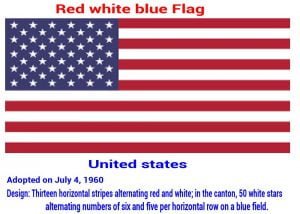
united-states-red-white-blue-flag
The current American flag was adopted on July 4, 1960, and consists of Red, White, and Blue color.
In terms of design the United States of American flag features thirteen horizontal stripes alternating red and white; in the canton, 50 white stars of alternating numbers of six and five per horizontal row on a blue field. The design and colors of the USA flag have been the basis for a number of other flags including Chile, Liberia, Malaysia, and Puerto Rico
What does the Red white blue color on the USA flag mean and represent:
The colors of the flag are symbolic as well; red symbolizes hardiness and valor, white symbolizes purity and innocence, and blue represents vigilance, perseverance, and justice. Read more
United Kingdom Flag
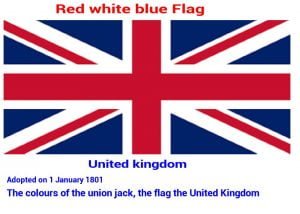
united-kingdom-red-white-blue-flag-union-jack
The united kingdom flag is also known as The Union Jack, or Union Flag was adopted on 1 January 1801. Red, white and blue. They’re the colors of the union jack, the flag the United Kingdom has presented to the world since 1801. It features the crosses of three patron saints – George (England), Andrew (Scotland), and Patrick (Ireland – although since 1921 only Northern Ireland has been part of the UK). Its official name is the union flag, but the BBC refers to it as the union jack, as per common parlance.
What does the colors on the United kingdom flag mean and represent:
White represents peace and honesty. Red symbolizes bravery, strength, and valor. Blue represents vigilance, justice, loyalty, and perseverance. Read more
Australia flag

australia-red-white-blue-flag
The Australian flag was Adopted on 14 April 1954. In the flag of Australia, there is the flag of the United Kingdom of Great Britain and Northern Ireland (Union Flag) at the top left, as Australia belongs to the Commonwealth of Nations. The flag has three elements on a blue background: the Union Jack, the Commonwealth Star, and the Southern Cross. The Union Jack in the upper left corner represents the history of British settlement.
Below the Union Jack is a white Commonwealth, or Federation, star. It has seven points representing the unity of the six states and the territories of the Commonwealth of Australia. The Southern Cross is shown on the flag in white. The red stripe on the flag represents the Australian Army, the dark blue stripe represents the Royal Australian Navy and the light blue stripe represents the Royal Australian Air Force. The Commonwealth Star and the boomerang on the Australian Defence Force ensign represent Australia. Read More
Czech Republic flag
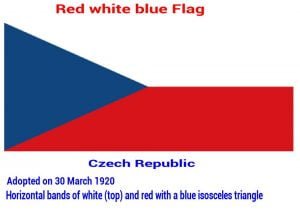
czech-republic-red-white-blue-flag
The national flag of the Czech Republic was adopted on 30 March 1920. It has a combination of red white blue colors, there are two equal horizontal bands of white (top) and red with a blue isosceles triangle based on the hoist side.
What do the Czech Republic flag colors mean and represent?
There is an important symbolic meaning behind the colors of the Czech flag. The white color stands for the people of the Czech Republic and their peaceful nature and honesty. Red color means courage, valor, and patriotism of the nation. The blue symbolizes vigilance, truth, loyalty, and perseverance. Read more
Liberia flag
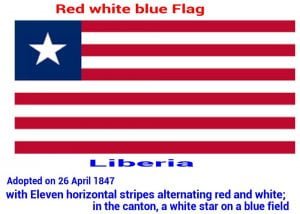
liberia-red-white-blue-flag
The Liberian flag was adopted on 26 April 1847. The colors of the flag bear a close resemblance to the flag of the United State, with Eleven horizontal stripes alternating red and white; in the canton, a white star on a blue field.
What do the Liberia flag colors mean and represent?
The eleven stripes symbolize the signatories of the Liberian Declaration of Independence and the red and white symbolize courage and moral excellence. The white star represents the first independent republic in Africa, above the blue square representing the African continent. Read more
North Korea Flag

north-korea-red-white-blue-flag
The flag of North Korea, also known as the Ramhongsaek Konghwagukgi was adopted on 8 September 1948. It is a combination of Red, white and blue colors design. It consists of a central red panel, bordered both above and below by a narrow white stripe and a broad blue stripe. The central red panel bears a five-pointed red star within a white circle near the hoist.
What do the North Korea flag colors mean and represent?
The colors of the North Korean flag – red, white, and blue – are considered national colors and symbolize respectively: revolutionary traditions; purity, strength, and dignity; and sovereignty, peace, and friendship.
The red star represents revolutionary traditions and the red panel is indicative of the patriotism and determination of the Korean people. The white stripes symbolize the unity of the Korean nation and its culture. The blue stripes represent the desire to fight for independence, peace, friendship, and international unity. Read more
Slovakia Flag
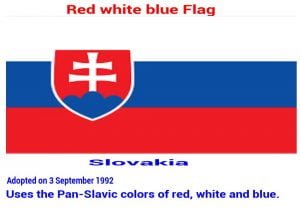
slovakia-red-white-blue-flag
The national flag of the Slovak Republic was adopted on 3 September 1992 and the flag, in common with many other flags of Slavic nations uses the Pan-Slavic colors of red, white, and blue.
What do the Slovakia flag colors mean and represent?
The same colors found on the Slovakian flag are found on almost every Slavic nation’s flag. Pan-Slavic colors—red, blue, and white—are found on the flags of many Slavic nations. They stand for Slavic unity and independence, and their use across nations represents the common origin of the Slavic peoples. Read more about the flag
Cambodia flag
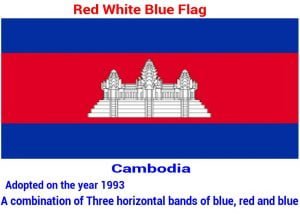
cambodia-red-white-blue-flag
The Cambodian flag was Adopted in the year 1993. It features a combination of Three horizontal bands of blue, red, and blue, with a depiction of Angkor Wat in white centered on the red band.
What do the Cambodia flag colors mean and represent?
The blue color represents Liberty, Cooperation, and Brotherhood, the Red color represents bravery and the White color (Angkor Wat) represents Integrity, Justice, and Heritage. Read more
Dominican Republic Flag
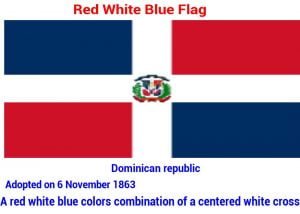
dominican-republic-red-white-blue-flag
The flag of the Dominican Republic was adopted on 6 November 1863. It features a red white blue color combination of a centered white cross that extends to the edges and divides the flag into four rectangles; the top ones are blue (hoist side) and red, and the bottom ones are red (hoist side) and blue.
What do the Dominican republic flag colors mean and represent?
The blue on the flag stands for liberty, the white for salvation, and the red for the blood of heroes. Read More
Luxembourg flag
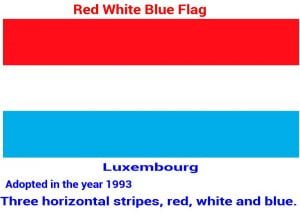
luxembourg-red-white-blue-flag
The national flag of Luxembourg was officially adopted in the year 1993.
It consists of three horizontal stripes, red, white, and blue, its colors were derived from the coat of arms of the House of Luxembourg.
What does the Luxembourg flag colors mean and represent?
The red color at the top of the flag signifies the power, revolution, and vibrancy of the people of Luxembourg. It also symbolizes the courage and domination of the Luxembourgian. The white color in the middle signifies the peace, harmony, and innocence of the people. The blue color at the bottom signifies the determination and perseverance of the people. Read more
Norway flag

norway-red-white-blue-flag
The national flag of Norway was Adopted on 13 July 1821. It features a combination of tricolor blue, red, and white that denotes the country’s liberty and independence. The concept was borrowed from the colors of the French, American, and British flags. It is made of a red background and has a blue cross superimposed on a white cross so that the white cross outlines the blue color
What does the Norway flag colors mean and represent?
The red and blue colors also explicitly referred to the same two countries, former and present union partners. The blue cross represents Norway’s union with Sweden and its past association with Denmark. The cross is also a symbol associated with Christianity and is common in most Nordic countries. Read More
Taiwan Flag (Republic of China)
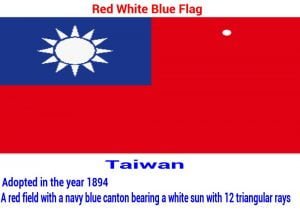
taiwan-red-white-blue-flag
The flag of Taiwan also known as the Republic of China was originally adopted in the year 1894. It features a design of A red field with a navy blue canton bearing a white sun with 12 triangular rays, making it one of the Red white blue national flags of the world. A national flag with Blue Sky, White Sun, and a Wholly Red Earth.
What does the Republic of China flag colors mean and represent?
Together, the three colors of the flag correspond to the Three Principles of the People: Blue represents nationalism and liberty; White represents democracy and equality, and Red represents the people’s livelihood and fraternity. Read more
Chile flag
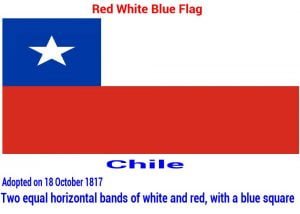
chile-red-white-blue-flag
The current national flag of Chile was adopted on 18 October 1817. It consists of two equal horizontal bands of white and red, with a blue square the same height as the white band in the canton, which bears a white five-pointed star in the center.
What does the Chile flag colors mean and represent?
Chile’s flag is a red, white, and blue banner with a white star. The blue square in the canton region of the flag represents the sky, the white stripe represents the snow of the Andes mountains, and the red symbolizes the blood that was spilled fighting for freedom. Read More
France Flag
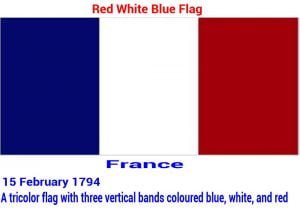
france-red-white-blue-flag
The flag of France was adopted on 15 February 1794. It is a tricolor flag featuring three vertical bands colored blue, white, and red. It is known to English speakers as the French Tricolour or simply the Tricolour.
What does the France flag colors mean and represent
The colors symbolize nobility (blue), clergy (white), and bourgeois (red), which were the estates of the old regime in France. When the Tricolour was formally adopted in 1794, its colors symbolized the values of the French Revolution: liberty, equality, brotherhood, democracy, secularism, and modernization. Read More
Nepal flag

nepal-red-white-blue-flag
Nepal flag the world’s only non-quadrilateral flag was adopted on 16 December 1962. It features a crimson red background with blue border and a white color symbol of emblem of a crescent moon and sun, making it one of the blue, white red national flags in the world.
What do the Nepal flag colors mean and represent?
The crimson red color indicates the bravery of the Nepali people. The blue color border on the flag represents peace and harmony. The white color moon and the Sun symbolizes the cool weather of the Himalayas and the heat and the high temperature of the southern lowlands respectively. You can read more about the Nepal flag here.
Panama flag
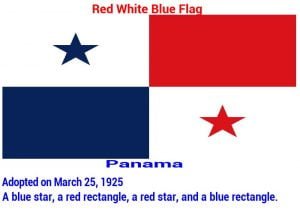
panama-red-white-blue-flag
The national flag of Panama was adopted on March 25, 1925. It features an amazing design of four rectangles going clockwise, each quadrant contains a blue star, a red rectangle, a red star, and a blue rectangle.
What does the Panama flag colors mean and represent?
The blue color represents the Conservative Party and the red to represent the Liberal Party. The white was intended to stand for peace and purity; the blue star stands for the purity and honesty of the life of the country; the red star represents the authority and law in the country, and together the stars stand for the new republic. Read More
Thailand Flag
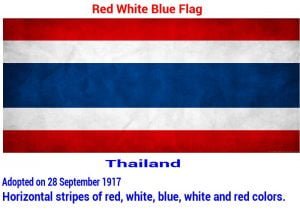
thailand-red-white-blue-flag
The flag of Thailand also known as the Tri-Rong flag was adopted on 28 September 1917. It has horizontal stripes of red, white, blue, white, and red colors. The central blue stripe is twice as wide as each of the other four colors.
What do the Thailand flag colors mean and represent?
The colors are said to stand for nation-religion-king, an unofficial motto of Thailand, red for the land and people, white for religions, and blue for the monarchy, the last having been the auspicious color of Rama VI. Read More
Costa Rica Flag

costa-rica-red-white-blue-flag
The national flag of Costa Rica was adopted on 27 November 1906. It featured a flag design of Five horizontal bands of blue, white, red (double width), white and blue.
What do the Costa Rica flag colors mean and represent?
The blue, white, and red horizontal design of the flag has a symbolic meaning and representation. The blue color stands for the sky, opportunities, idealism, and perseverance. The white color stands for peace, wisdom, and happiness. The red color stands for the blood spilled by martyrs in defense of the country, as well as the warmth and generosity of the people. Read More
Iceland Flag

iceland-red-white-blue-flag
The Iceland national flag was adopted on 17 June 1944. It has a design of A blue field with a white-edged and red Nordic cross.
What does the Iceland flag colors mean and represent?
For the Icelandic people, the flag’s coloring represents a vision of their country’s landscape. The colors stand for 3 of the elements that make up the island. Red is the fire produced by the island’s volcanoes, white recalls the ice and snow that covers Iceland, and blue is for the mountains of the island. The cross represents Christianity. Read more about Iceland Flag
Netherlands Flag
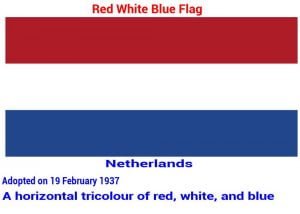
netherlands-red-white-blue-flag
The national flag of the Netherlands also known as the Dutch flag was adopted on 19 February 1937. It is a horizontal tricolor of red, white, and blue. The flag of the Netherlands is the world’s oldest tricolor – beating France, Italy, and Ireland, among others. The Dutch flag is often confused with the French flag which has exactly the same colors but instead of horizontal, it is vertical.
What does the Netherlands flag colors mean and represent?
The red, white, and blue on the Netherlands flag is recognized as the “colors of liberty” Read more
Russia Flag
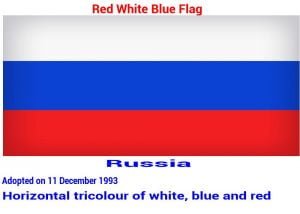
russia-red-white-blue-flag
The national flag of Russia was Adopted on 11 December 1993. It consists of a design horizontal tricolor of white, blue, and red, the flag’s origin also connects it to the tricolor used by the Dutch Republic.
What does the Russian flag colors mean and represent?
The white color symbolizes nobility and frankness, the blue for faithfulness, honesty, impeccability, and chastity, and red for courage, generosity, and love. Read More
Cuba Flag

cuba-red-white-blue-flag
The national flag of Cuba also known as the Estrella Solitaria, or the Lone Star flag was adopted on 20 May 1902. It consists of five alternating stripes of blue and white with a red equilateral triangle at the hoist, within which is a white five-pointed star.
What does the Cuba flag colors mean and represent?
The three blue stripes represent the three departments in which Cuba was divided at that time, the white color represents the purity of ideals and light; the red triangle, originating from the French Revolution – and the three ideals of liberty, equality, and fraternity: red for blood and courage; the star was the new state that should be added to the United States. Read More about the Flag
Laos Flag
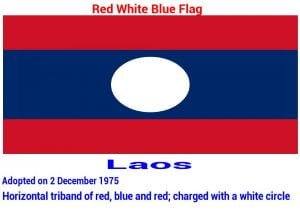
laos-red-white-blue-flag
The flag of Laos was adopted on 2 December 1975. It consists of a horizontal triband of red, blue, and red; charged with a white circle in the center.
What does the Laos flag colors mean and represent?
The Red color on the Laos flag represents the bloodshed of heroes in the fight for freedom; The Blue color represents wealth and the White color represents the full moon over the Mekong River as well as unity under the communist government. The blue in the Laotian flag meaning the Mekong River. Read More
New Zealand Flag
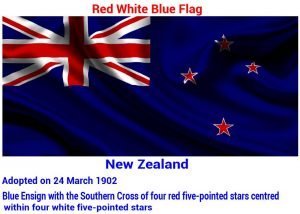
new-zealand-red-white-blue-flag
The flag of New Zealand was adopted on 24 March 1902. It is based on the British maritime Blue Ensign and consists of a Blue Ensign with the Southern Cross of four red five-pointed stars centered within four white five-pointed stars making eight stars in total with the colors dualing each other on the outer half of the flag.
What does the New Zealand flag colors mean and represent?
The flag of New Zealand uses two prominent symbols: The Union Jack and the Southern Cross. The national flag of New Zealand is predominantly dark blue and represents the sea and sky. In the top left corner is the union flag with the colors red and white. The Union flag represents the settlement of New Zealand by mainly British people after New Zealand became a British colony in 1840. Read More
Samoa Flag

samoa-red-white-blue-flag
The flag of Samoa was adopted on 24 February 1949. It consists of a red field with the blue rectangle on the upper hoist-side quadrant bearing the Southern Cross of four white larger five-pointed stars and the smaller star in the center.
What does the Samoa flag colors mean and represent?
In the Samoan flag, white is said to stand for purity, blue for freedom, and red for courage. No change was made in the national flag when the country became independent on January 1, 1962. Read More
Puerto Rico Flag
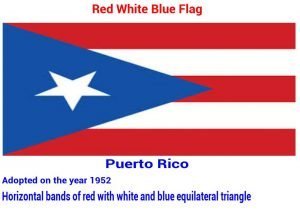
puerto-rico-red-white-blue-flag
The flag of Puerto Rico was adopted in the year 1952. It is a design of Five equal horizontal bands of red (top and bottom) alternating with white; blue equilateral triangle based on the hoist side bears a large, white, five-pointed star in the center.
What does the Puerto Rico colors mean and represent?
The flag of Puerto Rico represents and symbolizes the island of Puerto Rico and its people. The three red stripes represent the blood from the brave warriors. The two white stripes represent the victory and peace that they would have after gaining independence. The white star represented the island of Puerto Rico. The blue represents the sky and blue coastal waters. Read More
Malaysia Flag

malaysia-red-white-blue-flag
The flag of Malaysia was Adopted on: 26 May 1950. It is composed of a field of 14 alternating red and white stripes along the fly and a blue canton bearing a crescent and a 14-point star known as the Bintang Persekutuan (Federal Star).
What does Malaysia colors mean and represent?
The crescent represents Islam, the country’s state religion; the blue canton symbolises the unity of the Malaysian people; the yellow of the star and crescent is the royal color of the Malay rulers. Read More
Serbia Flag

serbia-red-white-blue-flag
The national flag of Serbia was a tricolor flag that was officially adopted on 11 November 2010. It features a design of three equal horizontal bands, red on the top and blue in the middle, and white on the bottom with the lesser Coat of arms left of at the center.
What does the Serbian flag mean and represent?
The main colors of the Serbian flag are red, blue, and white. The top red band symbolizes the bloodshed in the fight for freedom. The middle blue band represents the Serbian sky. Finally, the white band located along the bottom of the flag represents light. Read More
Fiji Flag

fiji-red-white-blue-flag
The national flag of Fiji was adopted on 10 October 1970. It features a design combination of a light blue background with the union jack flag colors n the canton with the shield from the National Coat of Arms centered in the fly-half.
What does the Fiji flag mean and represent?
The Fiji flag’s bright blue background symbolizes the Pacific Ocean, which plays an important part in the lives of the islanders, both in terms of the fishing industry, and the huge tourist trade. The Union Jack reflects the country’s links with the United Kingdom. The shield is derived from the country’s coat of arms, which was granted by Royal Warrant in 1908. It is a white shield with a red cross and a red chief (upper third of a shield). The images depicted on the shield represent agricultural activities on the islands and the historical associations with the United Kingdom. Read More
I am a crypto hobbyist, i offer Tips and Reviews on the best blockchain technology, crypto assets, emerging fintech trends, Country flags, banks virtual accounts, and the best Paying Legit Networks.
Check out my Latest Articles in the Following Categories here:
Cryptocurrency Payment System Countries Credit Card Reviews

